|
|
Post by matthewwalker on Nov 18, 2014 22:39:57 GMT -8
Well, I've been playing with this for a while now, and it's time to let you all in on it, and start to nail down the details. It's a secondary air tube placed directly in front of the port. It runs vertically the full height of the port, and about 1"-2" back from the port entrance. There is a slot running up the side of the tube facing the port. I've designed and built a few different arrangements, with different results, and am not set on one configuration yet. Generally though, it's a secondary air delivery configuration with a CSA of about 9% of system CSA, positioned to inject the air directly in front of the port, while adding beneficial turbulence patterns. In Montana we played a bit with trying to generate Kármán vortex sheets, and I was fairly intrigued with the idea. I built a simple tube injector that stood directly in front of the port in a batch, hoping the Karman effect would aid mixing. That worked very well, and I've since added a second air injector just prior to the generator tube with good results. Other configurations have that second air injector along side the tube, and below. All configurations seem to work well, and I'm still finalizing my preferred configuration. I've run this with primary air as low as 0%, with the caveat that there are leaks around my door so let's say less than 1 sq/in primary, up to about 2 sq/in primary. This is a 6" system firebox I'm experimenting on, so the secondary air consists of about 2.5 sq/in csa while the primary inlet on most of my tests has been around 1 sq/in. I'm getting very good results, and it's quite stable and predictable. It also leads to a very interesting show in the firebox, since the flames are not bent so violently towards the port. It's really something. Here's a load from Friday night... 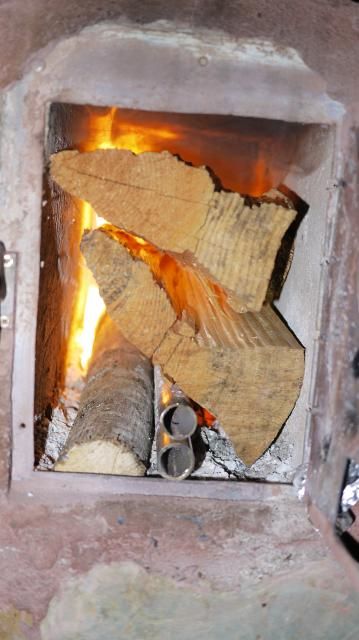 After I closed the door, I didn't touch it. The spikes are fuel drops, and I stopped it when O2 hit 16%, but heard the fuel drop and started up and it went for another 15 minutes or so. Here's the Testo graph.. 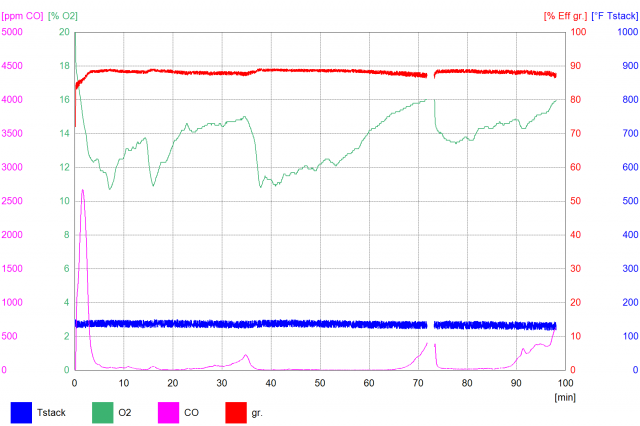 For a little while, the measurements looked like this... 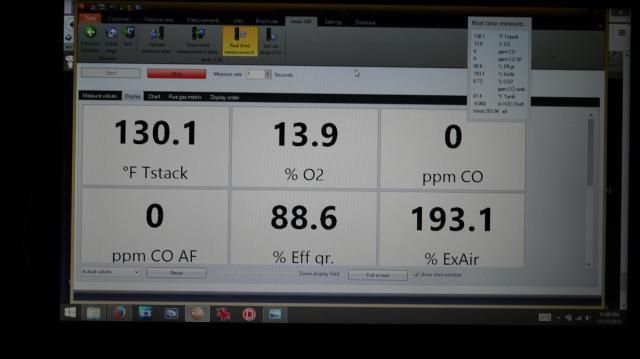 That was a good run. Average CO across the whole time, more than 90 minutes, was 117ppm. When it's burning, it looks like this... Here's a couple cool pictures of fluid around cylinders...   |
|
|
|
Post by matthewwalker on Nov 18, 2014 22:52:12 GMT -8
Since that run I've been refining it. Here's a few more runs... An early one... 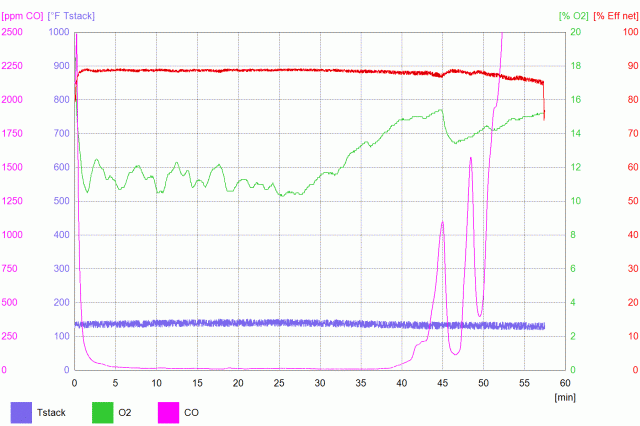 And here's four runs in a row from tonight, warts and all. I've been refining my numbers a bit, and spent some time today fixing leaks around the window and door, and building a sliding primary air baffle so I could narrow in on the right ratio. These runs are all 2.5 sq.in. secondary and just a few leaks worth of primary. Probably < 1 sq.in. primary. First run... 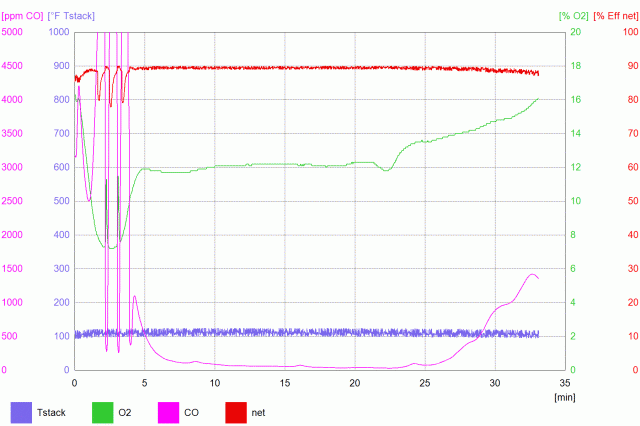 second... 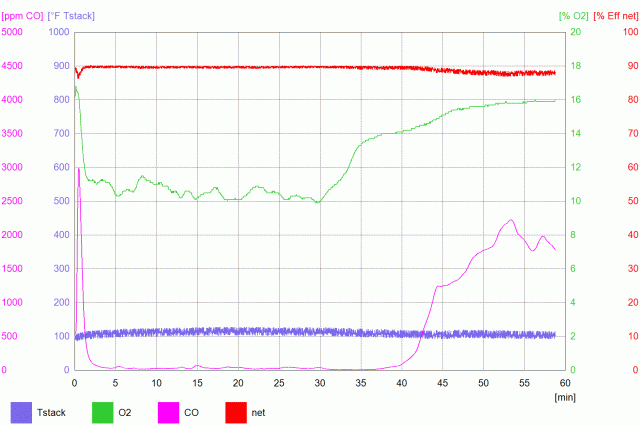 third... 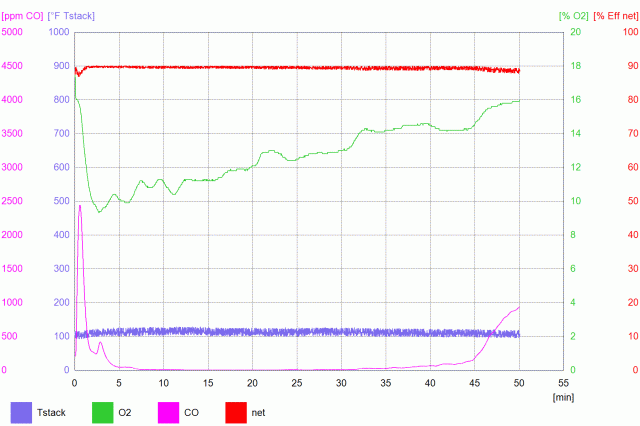 fourth... 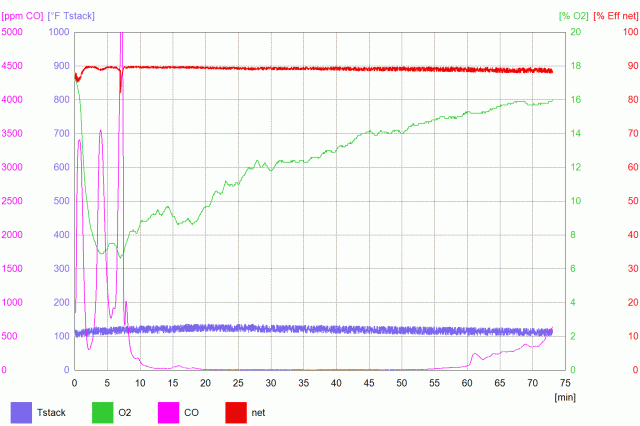 You can see it struggle in the first and last runs. In the first I loaded it onto flaring kindling and over fueled it for a few minutes, then it takes a bit to come up to temp so it's not as stable on the CO. By the last run, it chokes on wood gas on start up, from putting the wood onto a blazing coal bed. Once it recovers though, it locks in. Very long, very clean, very stable burns. And slow gas velocity in the box. |
|
|
|
Post by matthewwalker on Nov 18, 2014 23:01:26 GMT -8
So, that's enough of an introduction for now. It needs a decent name. I'm releasing the design under Creative Commons license, so you all feel free to use it and expand upon it. I need to thank Peter for helping me work through some of this and giving me invaluable insight and advice. Thank you Peter. More to come... |
|
|
|
Post by shilo on Nov 18, 2014 23:32:39 GMT -8
matthew channel 
|
|
|
|
Post by shilo on Nov 18, 2014 23:40:57 GMT -8
why not in the port? or after the port?
|
|
|
|
Post by satamax on Nov 19, 2014 0:07:47 GMT -8
|
|
|
|
Post by bernardbon on Nov 19, 2014 0:30:19 GMT -8
Nice Co  Combustion seems to move forward ? |
|
|
|
Post by PNW Dave on Nov 19, 2014 0:39:33 GMT -8
Since your method of injecting secondary air also seems be have a significant effect on the port itself, maybe "Walker Port" would be fitting.
|
|
|
|
Post by bernardbon on Nov 19, 2014 0:53:49 GMT -8
why not in the port? or after the port? successive turbulence seem more effective to stir the remaining particles burn without slowing the flow? hypothesis |
|
Deleted
Deleted Member
Posts: 0
|
Post by Deleted on Nov 19, 2014 4:38:08 GMT -8
Just use two L-shaped tubes with bores at the port area
and you get the same effect without violating the design of the of the S-portal.
But IP claims on obvious solutions are void anyway.
|
|
|
|
Post by peterberg on Nov 19, 2014 6:17:37 GMT -8
This looks very good Matt. And you're welcome. I wasn't aware of a second tube (in front or beside?) the first one. The two square pipes doesn't look very large and maybe this has something to do with the oversize ratio of 50% pipe vs slot. I'm not convinced there's a Von Kármán vortex street behind the tube with the air injector. But maybe there is, just in the port for a brief moment. An important effect of a ball or a round vertical tube in a gas stream is the wake behind it. This is an area of lower pressure, acting as a drag factor. See figure a of the picture below. So it could be a good thing or not that the velocity of the stream is limited by that drag factor. It also will suck air out the tube without effort. When you ever want to deminish the drag factor a trip wire would be a good idea. This will disrupt the boundary layer, thereby narrowing the wake. See figure b. Because it's not a sphere but a tube that trip wire could be two tiny vertical strips just in front of the thickest part of the tube.  Now that I can sit back and look from a distance I can't help to like the figure b much more. It looks like this will allow the pre-port tube to be closer to the port as a consequence of the compact yet strong wake. Maybe, just maybe, the relative high oxygen numbers you are getting are due to the situation which is illustrated by figure a. Remember, best induce the turbulence after the injection of air, not before or even at the same time. I've tried that in different setups and the results were consequently alike, all according to the trusted Testo analizer. And I hasten to add, much to my surprise. |
|
|
|
Post by matthewwalker on Nov 19, 2014 9:56:37 GMT -8
Thanks guys. Peter, I have done both single tube and double iterations. The single tube works well, I just can't get enough air downstream with the size tubing I've had available. I've been meaning to make one with 2" tubing, which would allow me to get the 9% csa I want, but I haven't done it yet. In the meantime, I've been increasing secondary csa by adding the second tube. Your comment about adding air then turbulence led to adding the second tube on top of the first, ending just before the vertical. That meant the hot secondary air was wrapping around the vertical tube and the mixing was increased. That configuration got me the 0 CO reading.
I'm not totally convinced that I'm creating a Karman sheet either, the squish of the port likely messes it up. You can look back there when the thing is roaring and see something like your image b, and the second image I posted above. It's quite dramatic, and looks like a violent mixing zone.
I'll take some pictures of the tubes and set ups I've tried so far. My neighbor fabricated something new for me last night, so hopefully I'll have a refined version to test and share this evening.
It's very different than the rocket I'm used to, so I'm still sorting out how to run it, what to expect, etc. It opens up some possibilities though, since it's possible to load up quite a bit of fuel and control the rate. That allows longer burn times than we are used to. It also, so far, requires a bit more operator skill to burn clean, the potential to burn dirty is greater than what I experienced with a J. So, I'm trying to design that out, although I think there will always be some of that. Currently it's acting much like a regular wood stove or masonry heater, in that you light it from cold, leave the door open for a few minutes until it's all engulfed, then shut the door and get it cruising on the secondary air. Different, but cool.
|
|
|
|
Post by shilo on Nov 19, 2014 12:33:59 GMT -8
why not in the port? or after the port?

|
|
|
|
Post by matthewwalker on Nov 19, 2014 12:43:34 GMT -8
Ha! Shilo, you are insistent! Here's your answer...I don't know. I haven't tried it. My gut tells me I'm getting better low pressure formation on the lee side of the tube by having it out in front of the port, so it's pulling in the secondary air and mixing it well as it heads down the port and into the riser. Also, it keeps the super hot zone in the bottom of the riser hot, rather than adding cooling air right where it needs to be hot. But yeah, I don't know, that's all just speculation. I do like the tube in front of the port for another reason, it stops fuel from clogging the port, and even with fuel right around it to the back wall of the box, the port stays clear and so does the air path. So far, I haven't been able to mess it up by fueling wrong. I am interested in casting a proper fire box with a floor channel to house the tube, and Peter's sloping floor to stack the coals right on top of it to reduce coaling times. As well, the tube should be easily removable for cleaning the port. Here's a photo of tube 1 and 2. Version 3 is in the stove, using square stock since it was all I had large enough to get me 2.5"sq. csa. 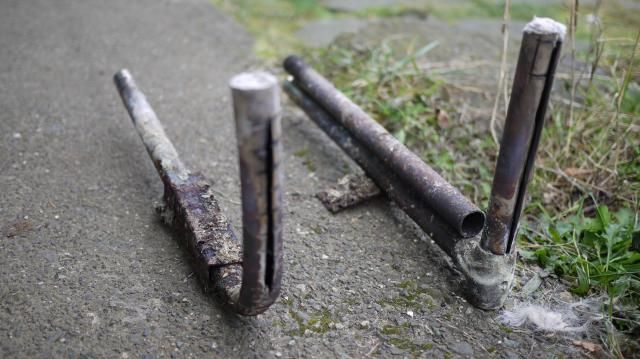 I started with the single tube, and although I could choke it down and get good results it was easily overfueled into a fuel rich state. So, I added the second tube for version 2. That one worked very well, and got me the 0ppm CO and the really long burn, but it too could be fairly easily overwhelmed since all told it's only about 1.5"sq. csa. So, I'm currently running about 2.5"sq csa in the secondary arrangement, and have a new tube to test tonight. |
|
|
|
Post by pinhead on Nov 19, 2014 12:59:42 GMT -8
Are your ports the same dimensions as the Peterberg standard? If your secondary air channel is inside the port, should the port/throat be widened to make up for the loss of CSA (to stay with ~70% of system size)? Sketchup that bad boy!  |
|



















 Combustion seems to move forward ?
Combustion seems to move forward ?



